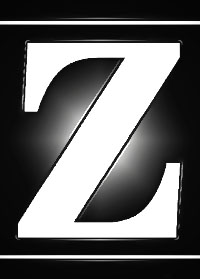
|

Stranger than "Da Vinci code" and for real!Jesus Christ was their ancestor, they keep His grave in Japan!Author: Augustin VidovićYou can give feedback to this article in its dedicated online forum. |
|
If you did ever read or hear of the best-seller "Da Vinci code", you know its main topic:
Jesus Christ lived after the cross, married, had children, and so on,
and his descendants are still living nowadays... but your aren't as
likely to have heard of some remote village located in the northern
regions of Japan, where since ancient times are located Jesus Christ's
tomb, his testament (yes, He wrote His will, in Japanese!), as well as
his still living descendants!
This is the true story we are going to discuss in this article. In a preliminary phase, we are going to enjoy our right to believe without restriction, while later we intend to apply a more critical approach to all the claims of this curious legend. Pour yourself a nice cup of green tea, and enjoy the ride! |
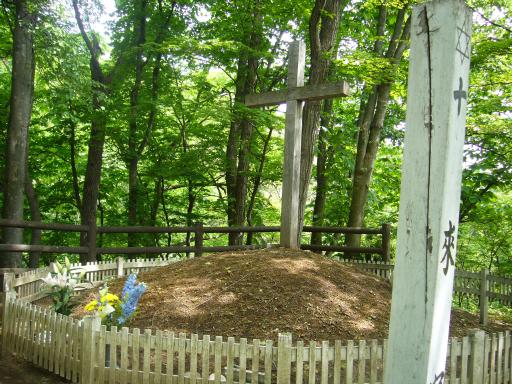
Part I, right to believe: A Village of MysteryIn Japan, Aomori prefecture (青森), between Lake Towada (十和田潮) and Hachinohe city (八戸, more about this name later), lies a hardly 3000 souls strong village, Shingo (新郷, literally "new village", part of which was formerly known as Herai, 戸来, which is still the name of the mountain in the eastern part of the village). |
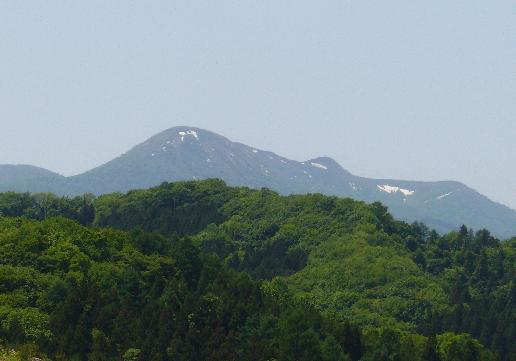
| Apart from its especially delicious garlic and its renowned yoghurt factory, it would only have the astounding beauty of its nature, where can still be seen straw roofs on top of which grass is growing, to offer as a sightseeing attraction... |
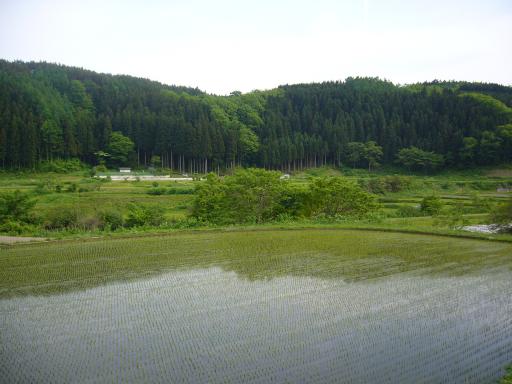
| ... If it was not for the fact that Shingo is also famous for being the place where Jesus Christ was buried! You can still go there a visit His tomb, which is an official landmark, located on road signs, and every year, the Christ Festival (キリスト祭) occurs, attracting a crowd of local performers and puzzled tourists. |
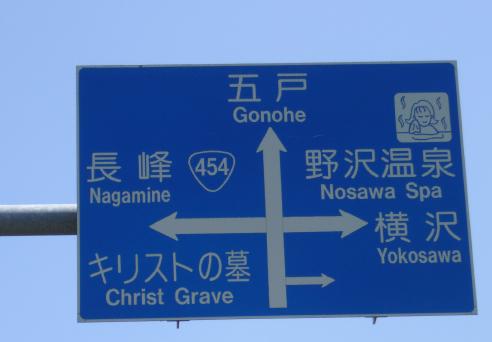
| Well, as an indication of its popularity, you certainly won't an amused grin out when you see the site entrance welcome panel, onto which can be seen, side by side, the cross representation and the trademark logo of some famous worldwide oversweetened soda. |
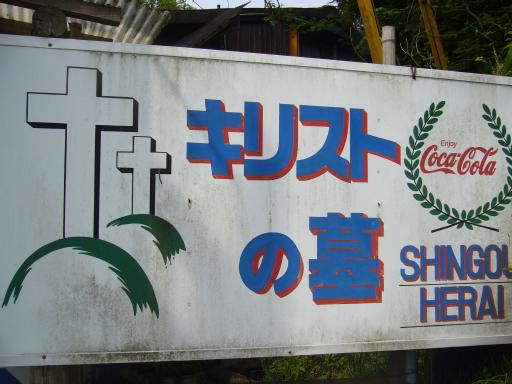
Here is the legend, as can be read in tourist brochures or be told by people
there:
When He was 21 years old, Jesus Christ (イエスキリスト) came to Japan and studied theology for 12 years. He came back to Judea at the age of 33 in order to preach, but people there rejected His teachings and arrested Him to crucify Him.The site of the tomb of Jesus Christ, which has now become a public park, complete with gardens, parking, fountains and even museum, is attracting every year some 10,000 visitors. This represents a considerable income for this region, far-off main communication hubs. In the photograph below, the cross-bearing lump of earth in the foreground is the tomb of Jesus Christ's little brother, the one in the back being Jesus Christ's tomb. The main access stairs, carved out in the hill slope, open out on the right, between the two white wooden pillars. Usually, in Japan, graves are marked with tombstones, onto which are generally written the names of those (or, most often, their ashes) who are buried. However, exceptionally on can spot a burial mound, as it is the case for the Chri(st) brothers. That kind of grave is traditionally associated with very important figures. |
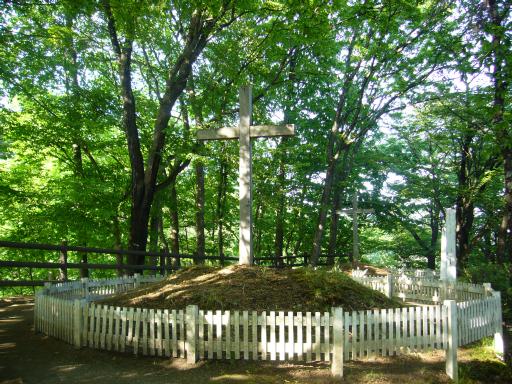
|
These two mounds are not the only graves in that place: a few meters down the
hill, there is a more "classical" graveyard, and among a number of other
tombstones scattered on the hill side, lies the easily visible family tomb of the
Sawaguchis, caretakers of this place since immemorial times. Coincidence?
I think not!, answers the famous researcher Kyomaro Takeuchi (竹内巨麿),
who, in 1935, in his family's library in Ibaraki prefecture (more in the south of
the country) unearthed some very ancient documents, thanks to which all this
story could be restored.
According to these Takeuchi documents, the Sawaguchi family is none other than the equivalent of the Saint-Clairs in the Da Vinci code, but in the real world: they are Christ's descendants. The discovery of these documents did cause a lot of agitation in the japanese press, at that time, and a great many pieces of evidence, which had no importance when considered isolately, made sense all of a sudden and corroborated this assertion, as we are going to see. |
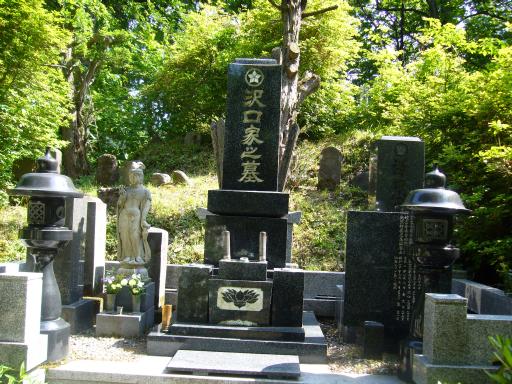
| By the way, you can see another kind of carved stones in the vicinity, which are not tomb stones, but Tanka (短歌), short poems sung slowly in a melodious voice. Those are there because of the Tanka contest taking place every year during the Christ Festival. |
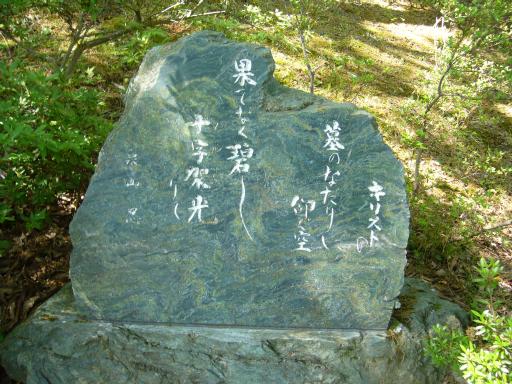
| On the same hill is also located the Denshoukan, to which most of the tourists pay a visit. |
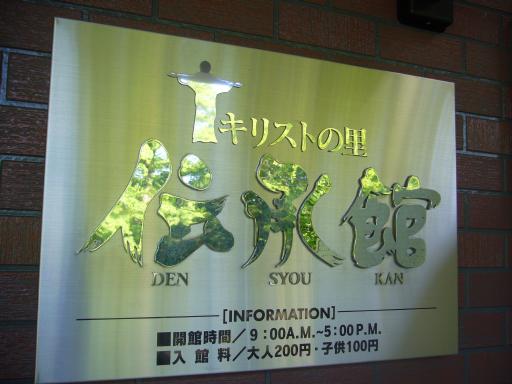
| In this museum are gathered historical documents and evidences of Christ's presence, it therefore is an unescapable visit for whoever is interested in the legend. |
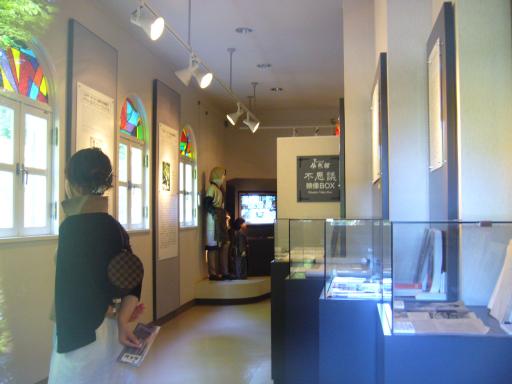
| It is nearly impossible to miss this 5 branches star, embly of the Sawaguchi family, in its prominent position: |
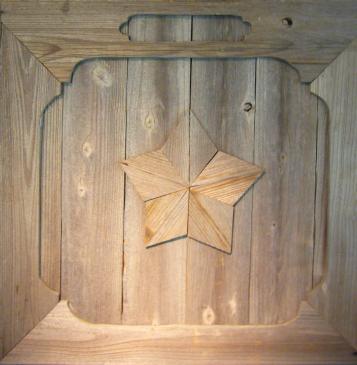
| Outside the hill, at a few dozen paces of the site entrance, you can see the original emblem, at the front of the Sawaguchi house, which is not a museum but a real house where are living people like you and me (well, according to the Takeuchi documents, not exactly like you and me): |
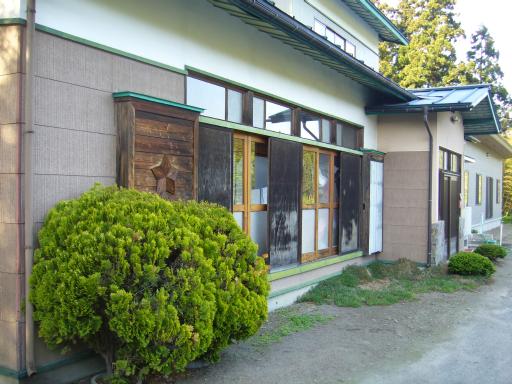
| The similarity of this family emblem this David's star, symbol of the hebrews since ancient times, is nothing short of breathtaking: |
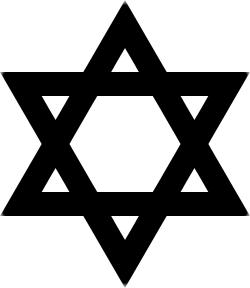
Moreover, if this story was not absolutely certain then why would Israel's
ambassador have come in 2004 to donate the plaque shown below, carved with the
following message in hebrew:
This plaque is a gift from the city of Jerusalem, as a token of friendship between the State of Israel, the city of Jerusalem and Shingo.The plaque, laid on the floor between the two tombs, can be seen by everyone. |
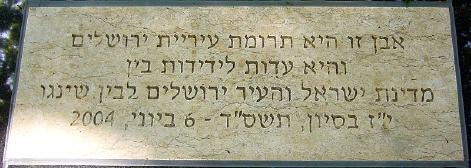
According to professor Eiji Kawamorita, an authority in hebraic culture, the
lyrics of the traditional song chanted each year at the Christ Festival, while
dancing around the tomb of Jesus Christ, the meaning of which being forgotten to
everybody, would have originally been hebrew language. For reference, these words
are, in their most complete version (given in the Shingo chronicle),
pronounced as follows:
Naniyaa dorayayo (ナニヤアドラヤヨ)It is a strange chanting, for more than one reason. Besides the fact that its meaning was lost, this song, which is to be heard only in Shingo, has no ending, in opposition to the general rule. And this nasare in the middle, doesn't it sound a bit too much like "Nazareth" ? But the orgy of evidence is not over yet! Let's take a look at the face of Mr. Sawaguchi's father, on the photo below; it's very hard not to notice the obvious semitic characteristics! |
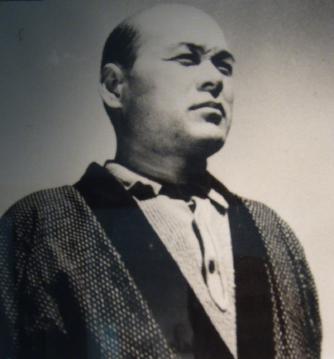
| The members of the Sawaguchi family are taller than average, their nose is longer than average, and lighter their skin complexion. That alone takes them apart and betrays their probable origin. Another element to add to our presumption is the stunning likeness of the traditional local costume to the typical hebrew outfit, as can be seen on the illustration below: |
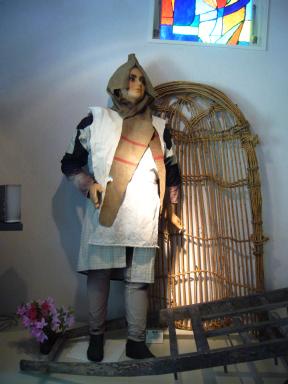
|
Moreover, if we put two mere minutes of thought into it, the village name, Herai,
derives much probably from the word "Hebrai", since its inhabitants are of hebrew
descent.
And what about that other peculiar ancestral local custom which consists in drawing a cross on newborns' foreheads, custom blindly followed, which origin is long lost in the mist of times? |
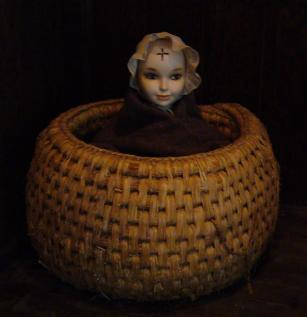
| On top of all this, here comes enough to sweep any remaining shadow of doubt out of the most skeptical rationalist, at this stage of the demonstration: the museum's masterpiece, the testament of Jesus Christ, written by His own hand, naturally in japanese! This testament was miraculously discovered in the famous Takeuchi documents. Jesus Christ describes the tomb and signs with His name, without any possibility of misidentification: |
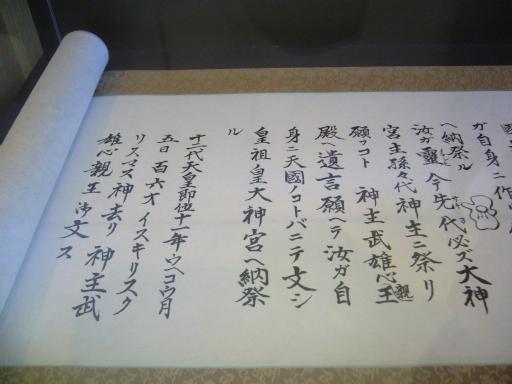
| Let's have a break: once you begin to recover from the shock of the exhibition, you can go to the museum shop, and eat a nice "Dracula" ice cream, which, in addition to being delicious (Shingo garlic is not renowned for no reason!), will turn vampires away. The crucifix drawn on the lid will finish repelling any vampire still surviving after the garlic (and a crucifix is right in the theme of the place)! |
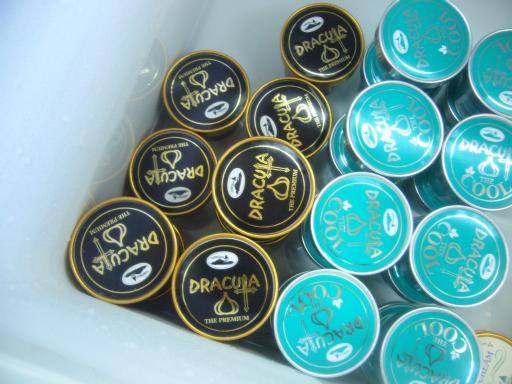
| You won't leave without this Chawan (tea cup) adorned with Nanya doyara song words: |
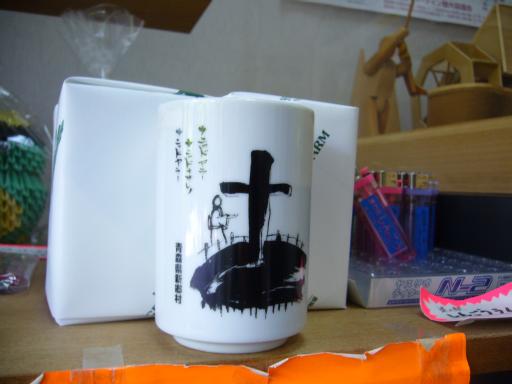
| At the end of the break, to bring back a souvenir, why not using this photo scenery, so convenient when you want to avoid hours of costuming? In the blink of an eye, here comes Jesus Christ and all His little family! |
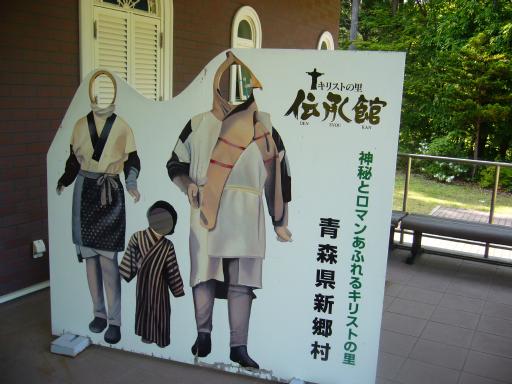
Part II : vigilance duty, When Tourism Office is in good terms with ArcheomaniacsIn order to wake up our critical mind a little, nothing compares to one more mystery. As a matter of fact, about 3 kilometers away from Jesus Christ's grave, can be admired not one, but two pyramids! The Big Stone God Pyramid (大石神ピラミッド), and, a few hundred meters on top of a lush hill, the Upper Big Stone God Pyramid (上大石神ピラミッド). |
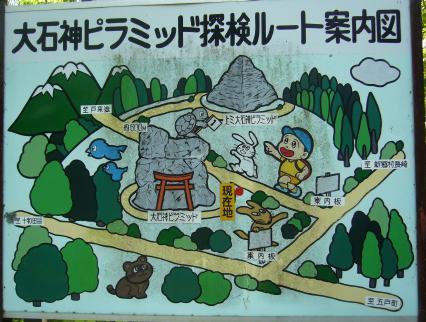
| The first pyramid is worshipped like a god, because it is located at the center of its own Shinto sanctuary, in plain nature. Shinto is the religion of nature, its gods are countless. This sanctuary has been existing for centuries, suffering no pollution by archeomania... |
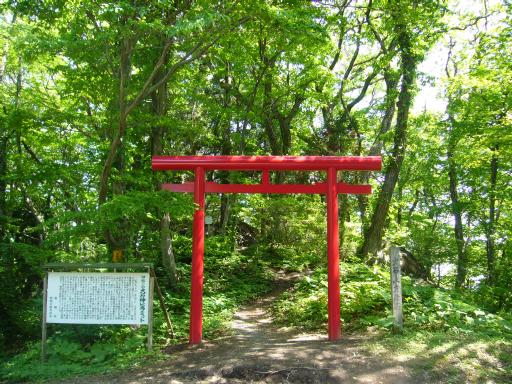
| But this somewhat recent explanation board tells a different story: it claims that pyramids in Japan are more ancient than egyptian or mexican ones, and that some very old document, found in the archives of the Takeuchi family (武内) in Ibaraki prefecture in 1935 (what a coincidence!) unveiled the existence of 7 pyramids in Japan. The famous pyramid hunter Katsutoki Sakai (酒井勝軍) and the film-maker Banzan Toya (鳥谷播山) named that very same year the Big Stone God Pyramid "Number 4 pyramid of Japan", etc. This same board explains the discovery of Jesus' tomb the same way. Two pyramids "older than egyptian pyramids" and a tomb supposed to be less than 2000 years old, discovered by the same individuals, using the same "ancient documents", that's a little bit too much. This smells, a hoax smell. Well, at least now we've got names. |
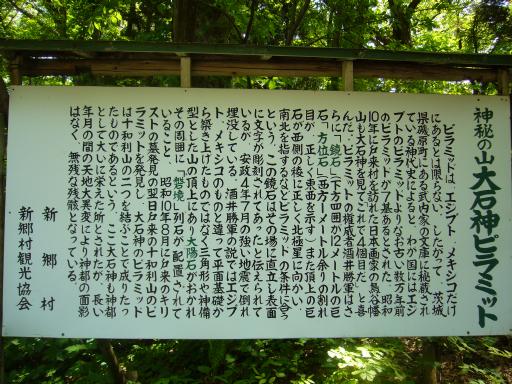
| Before we push our investigation further, let's enjoy the fine weather and visit both "pyramids" (both visits are recorded as videos on the DVD). First, the one inside the sanctuary is composed of several big stones, each of those was given a name. One of the stones is especially famous, it's the mirror stone (鏡石), because, as written on the accompanying panel, during a particulary strong earthquake, on 23rd july 1857, it felt right on the side on which were carved ancient inscriptions... talk about some misfortune! |
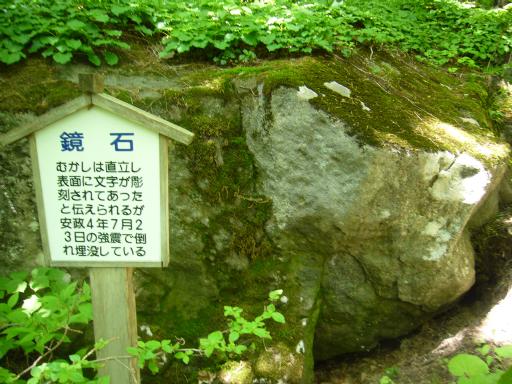
| The Upper Big Stone God Pyramid, in turn, doesn't have its own dedicated sanctuary. Well, to tell the truth, it ressembles much less a pyramid than a big stone on top of a hill. According to its legend, in ancient times, a golden sphere was located inside one of its numerous crevices... then again, what a lack of luck! |
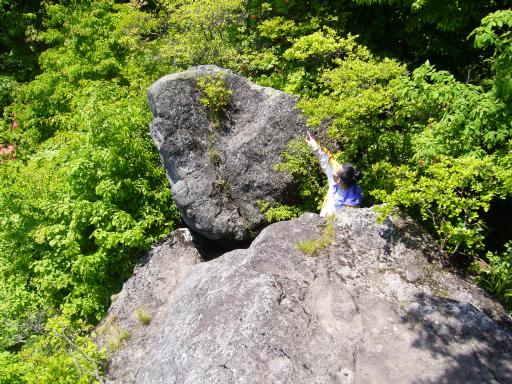
|
What about the relation between these pyramids and Jesus' grave? We've got
their common "discovery" year, 1935, a common source for "ancient" documents
about them -the Takeuchi documents- and now the name of the intrepid explorers:
Katsutoki Sakai and Banzan Toya. We still need another name, but it won't be hard
to find: the name of Shingo's mayor, a that time, for to whom does the operation
benefit, if not local tourism? The mayor at that time, as a matter of fact,
Denjiro Sasaki (佐々木伝次郎) was known for his relentlessness in seeking to
developing tourism in Shingo.
The year before, it had been decided to make Lake Towada a national reserve. To Sasaki's much despair, Shingo area had been excluded from the zone. Thus Sasaki invited film-maker Toya, notoriously in love with Lake Towada, in order to have him make some publicity for Shingo. But Toya's fondness was only for the lake, as he looked down on the village. However, Toya was also keen on fictious archeology, and brought with him his friend Sakai, who was already known at that time for his annoucement of the existence of seven pyramids in Japan. Together, 5 months before, they had gone on a quest for the "First pyramid in Japan", on Mount Hiba (比婆山ピラミッド). And so they went to the Big Stone God sanctuary, of which they declared, with much hype in the press, that it was the "Second pyramid of Japan". In 1935, everything seems in place, a single spark is needed for the fireworks to begin. That spark happens to be a man named Kyomaro Takeuchi, posing as the heir of the Takeuchi family (the family of the Documents), and also claiming to be an oracle. He came to Shingo that year and met Sasaki. One of his claims was that he had found inside the archives of his family ancient documents relating to events dating back to up to 317 billion years in the past (stronger than Ron Hubbard!) and enjoyed a crowd of fantastic archeology loving followers. On october 10th, after he left Shingo, the discovery of Jesus Christ's tomb was announced. By a strange coincidence, as soon as he came back home, Takeuchi digged up the testament of Jesus Christ from his archives! The first Christ Festival, an addition to the folklore of the village and a serious boost to local tourism (10% of the annual frequentation takes place on this single day), is celebrated some 30 years later. It seems that it takes about one generation to implant a new myth. |
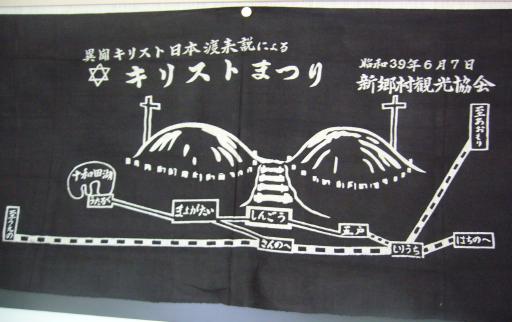
|
The "Christ Festival", recuring every year at the beginning of june, is in
itself a traditional festival, starting with a Shinto ceremony, which altar
is set up down the stairs to the burial mounds, a bon odori (盆踊り)
style dance -though the bon festival takes place in fact in august-
and then goes on with a gathering of the locals to drink, eat, chat while
looking at dances, songs, poems by those who prepared some (a few sequences
in video on the companion DVD).
The "Christ" part is the theme of the Shinto (!) ceremony, the tomb of Jesus Christ is used as a set for the Nanya doyara, but the remaining of the festival has a life of its own (it happens by the way in another location, where everybody is relocated once the Nanya doyara is over). This is an indication that the "Christ" theme of the festival is a recent addition. What about the weird words of Nanya doyara? After all, didn't professor Kawamorita, who is not a scammer, affirm its likely hebrew origin? Two things have to be pointed out: first of all, this dance is not specific to the Shingo village, it is spread across the prefectures of Aomori, Iwate and Akita. It is exact that the meaning was lost, but that is hardly surprising, Japanese being a very diverse language, in some regions people speak sensibly differently from japanese spoken in Tokyo. On the other hand, embarrassed by the fact that his name is associated with this story, professor Kawamorita, in his work Research on the hebrew song words in japan, holds this illuminating statement: During the summer of 1935, when I set foot in herai, the tomb of Christ did not exist yet [...] I have nothing in common with Kyomaro Takeuchi, who posed as an oracle and a remote descendant of Sukune Takeuchi (武内宿禰), and his group, Katsutoki Sakai, Banzan Toya, history researcher Kikue Yamakawa etc. who created that "Christ's grave" fantasy in Herai, and I refuse to bear that responsibility.But what becomes of the name "Herai"? Isn't it an alteration of "Hebrai"? Not at all. In all this part of the Aomori prefecture, and south of it Iwate, extends a string of towns which names are composed of a number followed by the character "戸" (door) : 一戸 (Ichinohe, "Door 1"), 二戸 (Ninohe, "Door 2"), etc. up to 九戸 (Kunohe, "Door 9"). The only exception being the absence of "Door 4", for "4" is an unlucky number in Japan -such a town's name would be pronounced like "The door to death". The character "Door" comes from an old custom; in all this region, the cattle was kept inside a common wooden enclosure. Inhabitants, living "at the door" (of the enclosure), were called "people of the wooden doors". Thus were composed the names of the villages. In 861, the 10th "door" was not named as such, because people had grown used to the "doors" being numbered from 1 to 9. Instead, the name "The door coming to 10" was contracted in "The coming door", or "Herai" (戸来). Of course, the story is outrageously shortened here, to the point of inaccuracy, but this illustrates the fact that Shingo's former name has nothing to do with hebrews. |
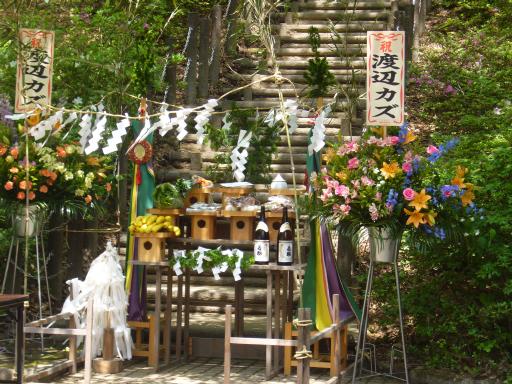
|
While we're at it, let's come back briefly to the Sawaguchi emblem, below. To claim that
is resembles a Star of David, even from far away, is obviously an exageration: how,
tracing two triangles, could one "miss" a branch?
Let's assume such a feat. Would have it been possible to identify "Star of David == jew" in the first century? King David, of whom this symbol is supposed to be the emblem, did not exist, at least as a powerful king, as he was at most a chief of village. For a long time, the "star of David" was used as a lucky charm, before being adopted as an identification symbol for jews during the Renaissance (16th century). The real jewish symbol during Christ's time was the menorah kept inside the temple of Jerusalem. The cross, in turn, was not adopted as a symbol of Jesus before the 5th century. The symbols used in the Takeuchi document are therefore anachronistic. And what about the "semitic" appearance of Mr. Sawaguchi? It has nothing exceptional! In the japanese population, taller, longer-nosed, lighter skinned than average individuals can be seen in every regions. Moreover, apart from the late Mr. Sawaguchi, the other family members, including Mr. Sawaguchi himself (interviewed in video on the DVD), are the average japanese type. |

| No, all things considered, as a great number of family emblems in Japan, the Sawaguchi star is simply a idealized flower like, for example, this one which grows on the slope of the hill where their family tomb is located: |
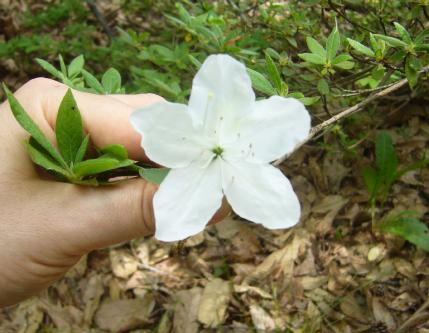
|
Now, let's look again at the famous "testament of Jesus Christ". Written in japanese?
2000 years ago? Come on! Japanese can write only since around the 6th century. As for the
katakana, used in this "testament", they appear only during the 9th century!
It is therefore perfectly impossible for a 2nd century document to have been written using characters
nonexistent at that time... unless, of course, His condition of son of God gave Jesus adequate
supernatural powers. Nethertheless, the form of the characters used suggests that the document
dates back to the first half of the 20th century, which is also the period during which Takeuchi
did announce his astounding discovery.
A last one before we hit the road: at the end of the "testament", Jesus Christ's signature, イスキリスクリスマス神, "Jsus Chris, Christmas god", how pretentious! So we are entitled to conclude that this Jesus and Santa Claus are a single entity! |
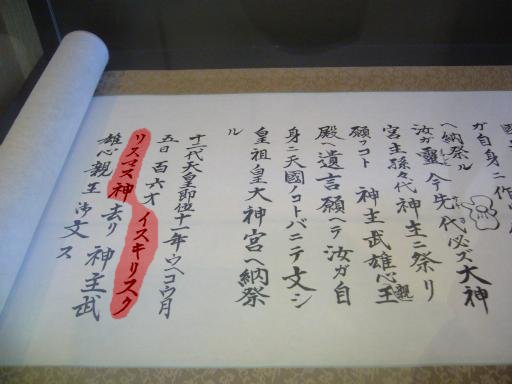
Afterthought: Not a problem after allAs we just saw, this "tomb of Christ" thing is merely a scheme to have tourists come to the village, and it is, indeed, a full success. Of course, nobody seriously believes it, in addition it is remarkably set up.Nethertheless it's an excellent pretext to go sightseeing some of the most beautiful landscapes in Japan, where the forest in hosting much wonders... Let's take another example. Did you know that, a few kilometers away from Christ's grave, you can find -at least, according to the local legend (see the photo below)- the real Garden of Eden? If you look a little, you will probably discover in the surroundings a number of local "mysteries". Mr. Imamura himself, Aomori prefect and popular figure, uses the english expression "Mystery tour", with his always smiling face. |
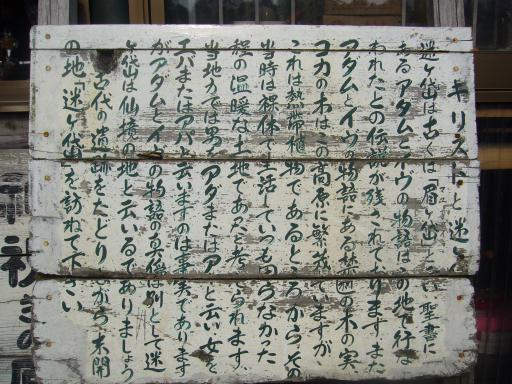
| The real miracles of this country are, as everybody will have understood, inside the benevolent imagination of its inhabitants. I for one invite you to go there for a trip, you are most likely to come back astounded (and with, why not, a bottle of Jesus sake in your luggage). |
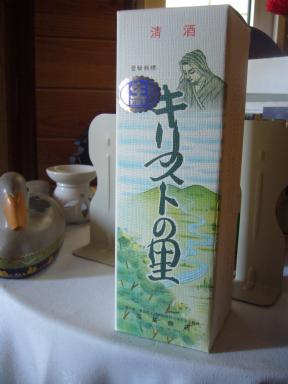
| We only touched the surface of the matter in this short article, but a much larger compilation of documents, including several hundreds of high definition photographs and scans, as well as a documentary on video, is in the works in the form of a DVD to be released. You can reserve your own now! |
References
- 新郷村史 (Shingo Chronicle), 新郷村史編纂委員会 (Shingo Chronicle editorial committee), 1988 (平成元年), no ISBN (available in the village, the present article author also owns a copy of it)
- 新・トンデモ超常現象 (Tondemo Files) 56の真相 (The truth about 56 paranormal phenomena - new volume) pp 10-16, 太田出版, 2001, ISBN 4-87233-598-8
- Shingo, the village of the descendants of Jesus Christ, DVD (video, images, files) published by 神秘の森, to be released in september 2006 (Reservation here)
- Tourist brochures related to Shingo (available on site, also scanned on the DVD)
Thanks (in no particular order)
- Olivier Aichelbaum,
- Paul-Éric Blanrue,
- Valérie Revelut and David Lapetina,
- Murray Gilbert,
- Yoshiteru et Yukie Ogasawara (Pension 野ばら),
- and of course M. Sawaguchi